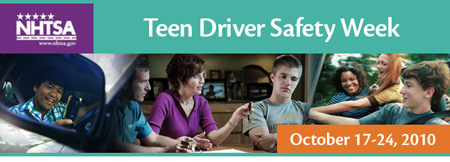

ITD encourages teenage drivers to adopt safe habits,
supports National Teen Driver Safety Week, Oct. 17-23
Teenage drivers need to keep their hands on the wheel, eyes on the road and thumbs off their phone’s keypad.
That message is part of National Teen Driver Safety Week that runs from Monday through Saturday (October 17-23). It offers parents and other adults an opportunity to remind young drivers that driving safely is their most important task when behind the wheel of a motor vehicle.
Idaho drivers, ages 15-19, were two-and-a-half times more likely to be involved in fatal and injury crashes last year. While this age group represented just six percent of all licensed drivers in Idaho, the group still accounted for nearly 15 percent of all drivers involved in fatal and injury crashes in 2009.
At the same time, driver inattention or distraction continued to be a leading contributor to all motor vehicle crashes in Idaho.
The National Highway Traffic Safety Administration (NHTSA) defines distraction as a specific type of inattention that occurs when drivers divert their attention away from the task of driving to focus on another activity instead.
Distracting tasks can affect drivers in different ways and are categorized into the following three types – visual, taking your eyes off the road; manual, taking your hands off the wheel; and cognitive, taking your mind off of driving.
While no one is exempt from driver inattention caused by array of electronic gadgets and other distractions brought into motor vehicles, teenagers seem to be particularly susceptible to the siren call of texting.
“Far too often, the devices are winning, and our kids are losing,” said Margaret Goertz with Idaho Transportation Department’s Office of Highway Operations and Safety.
A study by Pew Research Center’s Internet & American Life Project reported nearly half of the teenagers interviewed said they had been in a vehicle while the driver texted. One in three teenagers admitted to Pew researchers they had texted while driving.
The news is not all bad for teenage drivers. In Idaho, the number of young drivers in crashes has decreased, but ITD statistics show the number of young licensed drivers also has decreased by larger percentages or by the same percentage at the same time.
Nationwide, teenage driving deaths and involvement in fatal crashes have declined the last decade, according to NHTSA numbers.
Goertz cited driving programs that focus on youth, such as Graduated Driver Licenses and Alive at 25, as having a profound and positive effect on saving young lives on the highways.
Also, NHTSA anticipates that anti-texting laws and strong police enforcement may contribute to saving the lives of teenagers. Through the first six months of 2010, at least 30 states had passed legislation outlawing texting while driving.
In addition, awareness programs like National Teen Driver Safety Week help to educate both parents and teenagers about the important safety issue.
My Car. My Rules.
Goertz encourages all teenage drivers to set and maintain ground rules for their vehicle passengers in the spirit of “My Car. My Rules.”
“Start with ‘wear your seat belt,’” she said, adding that Idaho drivers younger than 18 can expect a fine and court costs totaling $61.50 if they or any passenger younger than 18 are not wearing seat belts.
“’Don’t pressure me to speed’ and ‘no drinking or drugs’ are two good rules to set,” she said. “Other rules can be agreed to and set within groups of young people who ride together regularly.”
Keeping the music down, no yelling, and keeping phone conversations short are examples of additional rules a young driver may require passengers to follow, Goertz explained.
Published 10-15-2010